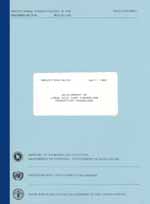
FIELD DOCUMENT
INSTITUTIONAL STRENGTHENING IN THE FISHERIES SECTOR
BANGLADESH
| BGD/87/045/92/23 | April 1992 |
 |
DEVELOPMENT OF LARGE SIZE CARP FINGERLING PRODUCTION TECHNOLOGY |
Prepared
by
ANDRAS PETERI
SHIBABRATA NANDI
and
SAMARENDRA NATH CHOWDHURY
MINISTRY OF FISHERIES AND LIVESTOCK
DEPARTMENT OF FISHERIES GOVERNMENT OF BANGLADESH
UNITED NATIONS DEVELOPMENT PROGRAMME
FOOD AND AGRICULTURE ORGANIZATION OF THE UNITED NATIONS
This field document is one of a series of reports prepared during the course of the project on Institutional Strengthening in the Fisheries Sector of Bangladesh. The conclusions and recommendations given in the report were considered appropriate at the time it was prepared. They may be modified in the light of further knowledge gained at subsequent stages of the project.
The designations employed and the presentation of the material in this document do not imply the expression of any opinion whatsoever on the part of the United Nations or the Food and Agriculture Organisation of the United Nations concerning the legal status of any country, territory, city or area or of its authorities, or concerning the delimitation of its frontiers or boundaries.
This document is in its final draft form. The opinions expressed by the authors are not necessarily those of FAO or the Government of Bangladesh.
Hyperlinks to non-FAO Internet sites do not imply any official endorsement of or responsibility for the opinions, ideas, data or products presented at these locations, or guarantee the validity of the information provided. The sole purpose of links to non-FAO sites is to indicate further information available on related topics.
This electronic document has been scanned using optical character recognition (OCR) software. FAO declines all responsibility for any discrepancies that may exist between the present document and its original printed version.
2. MATERIALS AND METHODS
2.1 Selection of ponds
2.2 Pond preparation
2.3 Stocking
2.4 Pond maintenance
2.5 Feed preparation and feeding
2.6 Sampling and harvesting
2.7 Survey of locally used fish seed production technologies
3. RESULTS AND DISCUSSION
3.1 Stocking
3.2 Length of season
3.3 Productivity of modified system
3.4 Growth and survival
3.5 Economics of fingerling production
3.6 Traditional contra modified system
4. CONCLUSIONS AND RECOMMENDATIONS
4.1 Stocking
4.2 Feeding
4.3 Manuring
4.4 General recommendations
The authors wish to express their gratitude to Dr. P.C. Choudhury, C.T.A. of FAO/UNDP Project BGD/87/045 for his advice and comments; to Mr. A.K.A. Rahman, Director of DoF, providing facilities in conducting field work. Special thanks are due to Prof. Abu Tweb A. Ahmed, Senior Technical Adviser, of the Project for designing and editing this paper.
To meet the present demand of large size (about 10 cm) carp fingerling for massive open water stocking in Bangladesh, a modified technology of large size carp fingerling production was demonstrated at four government farms, utilizing locally available facilities and feed ingredients.
In the modified system production was 1060–2292 kg/ha in 30–50 days. This rate of production in one cycle is about 4 times higher than the production under the traditional system of large size fingerling rearing.
With increased management skills, raising of 4–5 crops of large size fingerling was found technically feasible. This means that the improved system has the potential for producing 5300–5500 kg of large fingerling/ha/season. By further improvement of feeding system production can be increased up to 9000–10500 kg/ha/season by year round multicycle multispecies culture.
Against the traditional stocking rates of 40–140 prenursed fry/m2, the modified system used only 8–19 fry/m2, but produced a much higher biomass of larger fingerling of substantially higher sale value.
Production cost of 1 kg fingerling was Tk. 42. Profit over investment was Tk. 25 (60%) in modified system, which is significantly higher than the traditional (Tk. 19/kg i.e. 18%) technology. But the production cost of fingerlings in modified system will be Tk.27/kg when the farmers will use their own stocking material instead of buying. In that case the profit will be 148%.